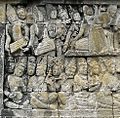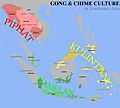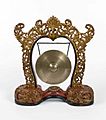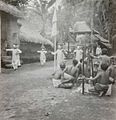Javanese gamelan facts for kids
The gamelan is a special kind of orchestra that comes from Java, an island in Indonesia. It was first played for the sultans, who were like kings, in Java. But now, you can find gamelan orchestras all over the world! They are in places like the United States, Japan, Australia, and even Ireland.
A typical gamelan orchestra mostly plays percussion instruments. These are instruments you hit, like gongs and drums. It also has a string instrument called a spike fiddle, a female singer called a sindhen, and a group of male singers. The gamelan often plays music for traditional Indonesian dramas, like Wayang Kulit (shadow-puppet shows) and Wayang Wong (dance-dramas). They also perform concerts just by themselves.
Contents
What is Gamelan Music Like?
Gamelan music is very unique. It has a special sound that is often calm and peaceful, but it can also be exciting and powerful. The music is usually played in a repeating pattern, with different instruments adding layers of sound.
The Instruments of Gamelan
The gamelan orchestra has many different instruments. Most of them are percussion instruments made of bronze or iron.
Gongs and Metal Instruments
- Gongs: These are large, round metal instruments that make a deep, booming sound. There are big gongs and smaller gongs.
- Metallophones: These are like xylophones, but with metal bars instead of wooden ones. Players hit the bars with mallets to make sounds. Examples include the saron, gendér, and slenthem.
- Bonang: This instrument has many small gongs laid out horizontally on a frame. Players hit them with mallets to create melodies.
Other Instruments
- Kendang: These are drums that are played with hands or sticks. They help keep the rhythm and tempo of the music.
- Rebab: This is a two-stringed instrument that looks a bit like a violin. It adds a smooth, flowing melody to the music.
- Suling: This is a bamboo flute that plays high, airy melodies.
- Singers: The sindhen (female singer) sings beautiful melodies, and the male chorus adds harmonies and chants.
Where is Gamelan Played?
Gamelan music is very important in Indonesian culture, especially in Java and Bali.
Gamelan in Java
In Java, gamelan is often played in royal palaces for ceremonies and performances. It is also used to accompany traditional arts like Wayang Kulit (shadow puppets) and Wayang Wong (dance-drama). The music helps tell the stories and set the mood for these performances.
Sacred Gamelan
Some gamelan sets are considered very sacred and are only played for special religious ceremonies or important events. For example, the Gamelan Sekaten is played during a big celebration called Sekaten at the Keraton Yogyakarta (Yogyakarta Palace).
Gamelan in Bali
Balinese gamelan is often faster and more energetic than Javanese gamelan. It is a big part of religious ceremonies in temples and accompanies many dances, like the Legong and Barong dance. Children in Bali often learn to play gamelan from a young age.
Gamelan Around the World
Gamelan has become popular far beyond Indonesia. Many universities and communities in other countries have their own gamelan groups. People from different cultures enjoy learning and playing this unique music. It shows how music can connect people from all over the globe.
Images for kids
-
Musicians performing musical ensemble, The 8th century bas-relief of Borobudur Temple, Central Java, Indonesia
-
Gamelan is mentioned in the Kakawin Nagarakertagama in a palm-leaf manuscript called lontar that was written by Mpu Prapanca in 1365 AD. A collection of National Library of Indonesia in Jakarta
-
The court of the Sultan of Yogyakarta, c. 1876. Performance of Bedhaya Sacred Dance accompanied by Javanese Gamelan Ensemble
-
Javanese Gamelan Munggang (one of sacred gamelans) being played (as part of ritual) in Surakarta Sunanate, Central Java, Indonesia, 2000
-
Javanese Gamelan in Asian Civilisations Museum, Singapore
-
Balinese Gamelan in Museu de la Música de Barcelona, Spain
-
K.P.H. Notoprojo, a famous Indonesian Javanese Gamelan and Rebab player, between 1945 and 1955
-
The three major indigenous genres of gong-chime music prevalent in Southeast Asia: this includes the Gamelan of western Indonesia; the kulintang of the southern Philippines, eastern Indonesia, and eastern Malaysia; and the piphat of Thailand, Cambodia, Laos and Burma
-
Pande (Gamelan Maker) is burning Gong in Besalen in Central Java, Indonesia
-
Gamelan is used by patients at Sumber Porong Mental Hospital in Java, between 1902 and 1922
-
K.R.T. Rahayu Supanggah, one of gamelan maestros. He introduced gamelan to almost the entire world, actively researching, writing, training, creating compositions, teaching, and performing
-
Gong Lanang
-
Gong Wadon
-
Gong Klentong
-
Kendhang Semaradana
-
Javanese gamelan being played in Keraton Yogyakarta, Indonesia, on 25 October 2009
-
Wayang Kulit performance with Gamelan accompaniment in the context of the appointment of the throne for Hamengkubuwono VIII's fifteen years in Yogyakarta, between 1900 and 1940
-
A gamelan ensemble with a group of singers (Sindhen (Female) and Gerong (Male) at the Mangkunegaran Royal Palace in Surakarta, Central Java, between 1870 and 1892
-
A Gamelan Ensemble was played to accompany the inauguration of the Prince of the late Paku Alam VII at Pakualaman Palace, Yogyakarta, Indonesia, before 1949
-
Gamelan orchestra in East Java, late 19th century
-
Balinese girls practiced legong dance accompanied by gamelan in Ubud, Bali, Dutch east Indies, between 1910 and 1930
-
Balinese gamelan being played in Kuta, Bali, Indonesia, on 23 September 2010
-
Sundanese Gamelan ensemble of Bandung's Regent, West Java, Dutch east Indies, between 1857 and 1890
-
A gamelan laras slendro Si Ketuyung (sacred gamelan), a set of gamelan instruments made in 1748, a legacy of Sultan Sepuh IV, Keraton Kasepuhan, Cirebon, Indonesia
-
Gamelan Degung Ensemble, This photo was taken at Annual Exhibition in Java. between 1910 and 1930
-
Melasti, a self-purification ceremony to welcome Nyepi by all Hindus in Bali. This ceremony is held on the beach with the aim of purifying oneself from all bad deeds.
-
The Sundanese Jaipongan Langit Biru dance performance in West Java Pavilion, Taman Mini Indonesia Indah, Jakarta
-
Balinese Ramayana dance drama, performed in Sarasvati Garden in Ubud, Bali
-
King Duryodana in Wayang wong performance in Taman Budaya Rahmat Saleh, Semarang, Jawa Tengah, Indonesia
-
Ramayana Ballet Performance near Prambanan Temple complex in Yogyakarta, Indonesia
-
Dalang (Puppet master), Sindhen (traditional Javanese singer), and Wiyaga (Gamelan musicians) in Wayang Kulit Show in Java
-
Wayang Golek Performance in Yogyakarta
-
Kethoprak (Javanese popular drama depicting legends, historical or pseudo-historical events). Performance by Kethoprak Tobong Kelana Bhakti Budaya, Bantul, Yogyakarta, Indonesia
-
Sandiwara performance, West Java, Indonesia
-
Gamelan performance at Borobudur International Performances and Art Festival 2018
-
Kyai Barleyan, a Javanese gamelan at Oberlin College in Ohio. Acquired in 1970, it is believed to be the third-oldest gamelan in use in the United States.
-
Gamelan Son of Lion, a Javanese-style iron American gamelan based in New York City that is devoted to new music, playing in a loft in SoHo, Manhattan, United States in 2007
-
Sundanese Gamelan Degung being played in Museo Nacional de las Culturas Mexico, Indra Swara Gamelan Group, on 2 April 2018
-
The Sundanese Jaipongan dance performance accompanied by Gamelan Ensemble in West Java Pavilion, Taman Mini Indonesia Indah, Jakarta
-
A gamelan ensemble consisting of children in a temple complex in Bali, between 1910 and 1920
-
Children practiced dance with gamelan at Kebun Dalem Semarang, Dutch east Indies, circa 1867
-
Gamelan Kaduk Manis Rengga (sacred gamelan) from Kraton Surakarta, Java, 2003
-
ayang klithik (flat woodden puppet) performance with a gamelan orchestra in Ngandong , Java, in 1918
-
Gamelan Sekati (One of Some Javanese Sacred Gamelan in the Keraton Yogyakarta) is being played to accompany Sekaten Ceremony in front of Kauman Great Mosque in Yogyakarta, Indonesia, on 27 April 2004
-
Gamelan Nyi Asep Mangsa, Indra Swara, México, on 27 March 2015
-
A Gamelan Ensemble accompanies Wayang Kulit Show (the Indonesian Shadow Play) in Java, circa 1870


















































































